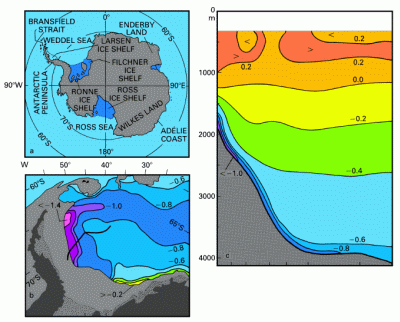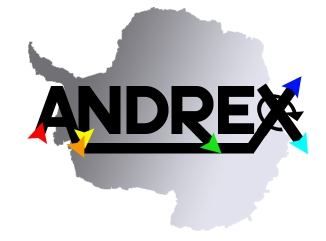Background
During the last seven decades, the Weddell gyre has been persistently regarded as by far the primary region of formation of Antarctic Bottom Water (AABW, the water mass that integrates the deepest layers of the MOC), and of ventilation of the deep Southern Ocean, two phenomena that have often been presumed to be equivalent. Further, the gyre’s role in global biogeochemical cycling has been deemed marginal on the grounds of its relatively small spatial extent.
 |
Formation of bottom water in Weddell Sea |
| (a) Location map, (b) potential temperature (ºC) at ocean bottom - the 3000m contour is indicated by shaded region, and the stippled area indicates the ice shelf, (c) a vertical section of potential temperature, along the heavy line in (b). Source: [Tomczak and Godfrey, 2003] after [Warren, 1981] |
We now have several pieces of evidence that challenge this traditional view of the Weddell gyre. On the one hand, they question the gyre’s high-ranking status in AABW production, the equivalence between this process and ventilation, and the gyre’s assumed lack of biogeochemical relevance in a global context. On the other hand, they expose the gyre as a highly variable region on climatically sensitive (decadal) time scales and suggest that AABW export out of the gyre is substantially more complex than previously thought.
This emerging new view of the Weddell gyre will be tested by measuring the transports of water masses and physical and biogeochemical tracers across the gyre’s outer rim. This will be the first time that the oceanic exchanges between the Weddell gyre and the rest of the ocean are measured in a thorough and systematic manner, thus putting our understanding of the gyre on a par with that of deep water formation regions in the North Atlantic.
References:
Tomczak, M., and J. S. Godfrey (2003), Regional
Oceanography: an Introduction, 2 ed., 390 pp.,
http://www.es.flinders.edu.au/~mattom/regoc/.









